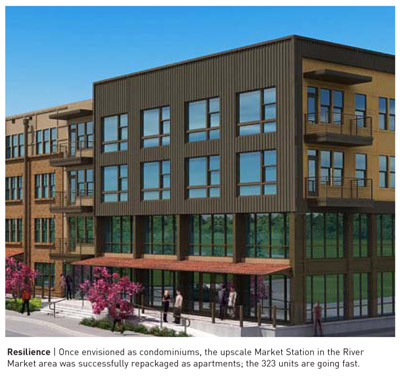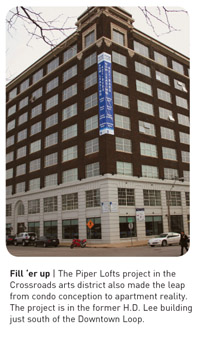HOUSING OPTIONS, ENTERTAINMENT VENUES AND MORE ARE ADDING UP TO A CRITICAL MASS FOR BUILDING A DOWNTOWN RESIDENTIAL BASE. CONFIDENT RETAILERS ARE CATCHING ON.
Although success definitely breeds success, Downtown Kansas City’s accomplishments have also included challenges.
While the area has seen more than $5.5 billion in development over the past decade, there is a tendency to expect that almost frenetic pace to continue. The growing footprint of development can also make it difficult to assess recent projects—and where changes might be made.
Not surprisingly, the most visible issues involve the biggest projects. Local residents, though, and even community leaders may have less control over these issues than smaller ones.
A good example: East Village. Arguably one of the largest issues remaining on the Downtown redevelopment table, proponents are hoping to snag a big fish with a new General Services Administration federal office building. At one time planned as a consolidated location for up to 1,200 federal workers, the GSA facility has been delayed by consideration of other sites and alternatives. Along with most local leaders, the area’s congressional representatives continue to urge a Downtown Kansas City location.
“After GSA rejected their own previous plan to house Kansas City federal workers, which this and the previous administration agree is a must-do, we are awaiting completion of their alternative plan of action, which we hope is only days away,” noted Shanna Marchio, communications director for U.S. Sen. Kit Bond.
The approximately $340 million, nine-block East Village already has the new, $60 million J.E. Dunn headquarters and is slated for extensive residential and retail development. But the much larger GSA office and its employees could be a major catalyst for the project’s success.
Other big projects continue on track. The $400 million Kauffman Center for the Performing Arts remains on schedule for a 2011 completion, while the new center for the Kansas City Ballet started construction this year as expected. Other major projects include the $280 million Paseo Bridge replacement project and $70 million in work at the Charles B. Wheeler Downtown Airport.
BUILDING BLOCKS
Several smaller, yet highly strategic developments, remain less evolved, though progress is visible.
The 18th and Vine Jazz District is a relatively compact but notable Downtown area that in many ways has yet to achieve its total potential. Changes include continued efforts with the Downtown Council in areas such as marketing, and a new sign to help lure visitors to other areas such as the nearby Crossroads district.
The Jazz District is also important in Downtown’s growing cultural and arts venues. Completion of the Kauffman center and more marketing of city’s growing theaters, galleries and museums is bringing regional, even national notice. The Jazz District, one of the few areas with proven international stature, can be a major component to that future.
Similar potential exists for other fields such as health care, higher education and research. Though never coordinated here to the extent of the Kansas bioscience effort, these areas are already sizable and growing components of Greater Downtown. And even though a sales tax to build one or more of these areas is unthinkable in this or any foreseeable political climate, opportunities exist: incentives for affordable housing to promote one of these job-creating industries could be a significant but affordable option, for example.
VACANCY EVALUATION
The biggest story in today’s Downtown may be in traditional office and residential real estate markets. With some of the highest vacancy rates in the area for Class A office space and very slow condominium sales, these at first appear largely as negatives. But they may overshadow important developments and even more potential.
The recent shift of for-sale residential property to rental is a good example. Some locations, such as the Piper Lofts, in the former H.D. Lee building on West 20th, and the former J.I. Case building on West 22nd in the Crossroads district, successfully made the transition from condominiums to apartments, even after reconstruction efforts began. Nearly half of one project was rented within weeks of its opening, while similar success has accompanied the upscale Market Station, a 323-unit apartment complex in the River Market.
Other “conversions” involve property owners who decide not to fight a slow market and instead use a location themselves. Frank and Jolyn Sebree recently opened the Majestic restaurant at 931 Broadway. A steakhouse by the same name had rented the property until earlier this year, but when it closed, the Sebrees decided the underlying market was strong enough to try the operation themselves.
“It isn’t a good time to sell or lease,” Frank agreed. “But there’s a lot of demand here and it’s a good time to hire. It might be a good time to see if we can put something together.” The Majestic, now with a bistro theme, opened Nov. 9.
Sebree’s perception of demand is notable. Although such thinking would have been a stretch 10 years ago—or even five—the presence today of many new businesses and apartments in and around the Garment District supports his logic.
“There are a lot of people who live and work in this neighborhood,” he said. “It’s become an interesting place to be.”
FIGHTING BACK
A problem shared by both commercial and residential property involves financing. Commercial developers and entrepreneurs cannot get capital any more than would-be condo buyers, a primary reason both markets contracted here and across the nation. Some have found a solution by creating answers of their own.
Annie Marie Bennett of KC Loft Central noted “carry-back loans” were one avenue being utilized by some condo owners to promote sales of their property. Effectively a form of owner financing, carry backs are usually paired with another loan or upfront payment, but the result is that buyers can often get financing where it is not currently available.
“It’s a lot harder than it used to be, but it’s not impossible,” to get people into lofts, she said. “As long as the clients are educated, there is product out there.”
The parallel problem in commercial property involves capital for developers rather than end-users. Either way, the tightness of the loan market is a factor and involves both public and private lenders—banks and entities such as the Small Business Administration.
“There are people who want to develop, but they can’t get loans,” noted Tom Trabon, outgoing chairman of the Downtown Council. “The lending arena is just not lending.”
That reality, and a complex blend of regulation and incentives, is among the reasons most Downtown supporters urge a return to more aggressive strategies at City Hall. “We have faced a lack of focus at City Hall and faced an economy that is not good for the real estate development industry,” Trabon added. “The city has to establish a policy that will help out if they buy into Downtown. The alternative is just no development. We can’t make the economy better than what it is.”
Developer Jon Copaken noted that private developers continue to make investments, even in the weak markets. “You’re finding retailers who are confident enough in their business that, despite the economy, they know they can do business and are willing to put their money, their employees and their reputation there,” he concluded. “Even in a very anemic world, you’re seeing an impressive array of life.” ![]()
